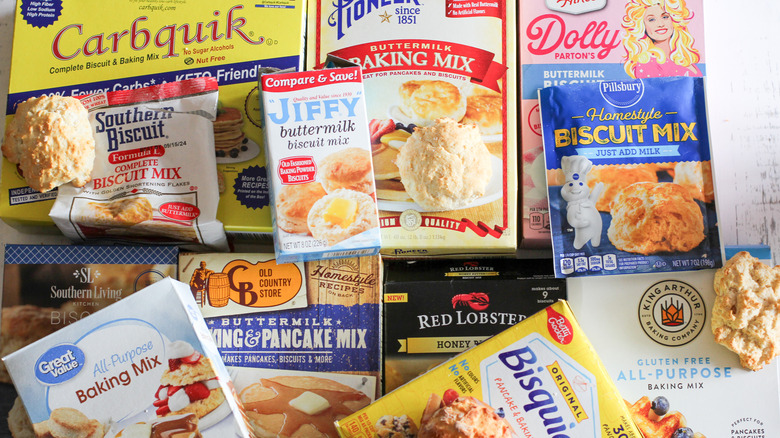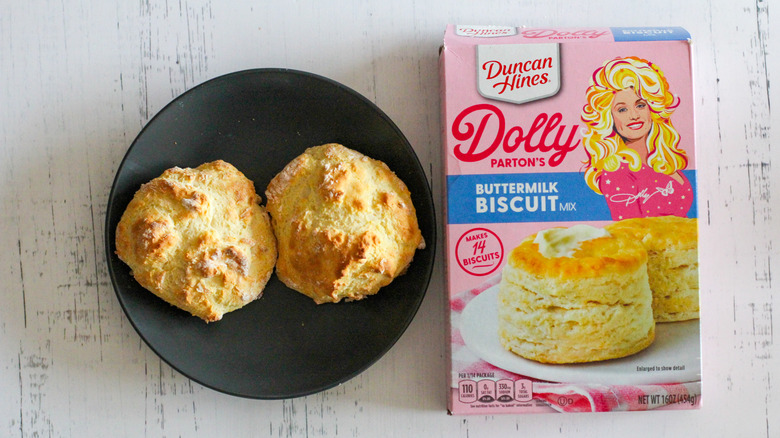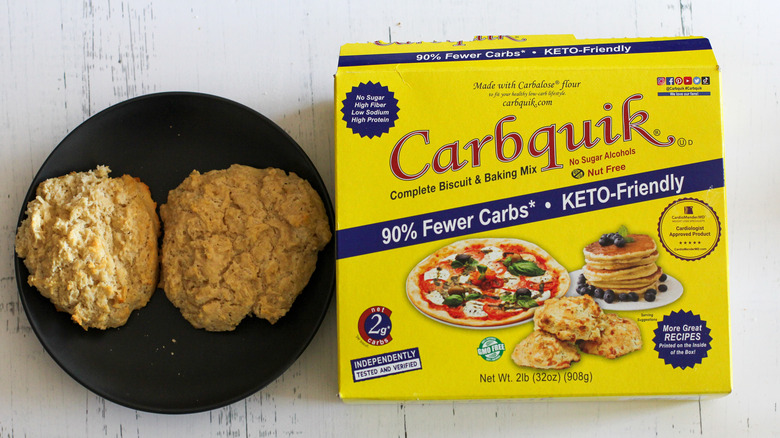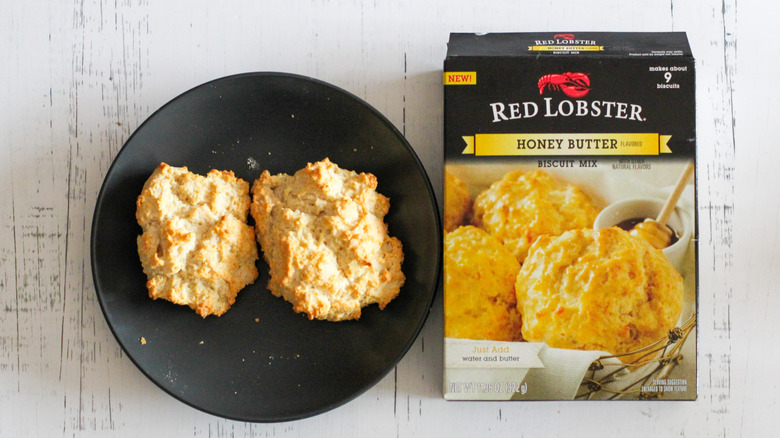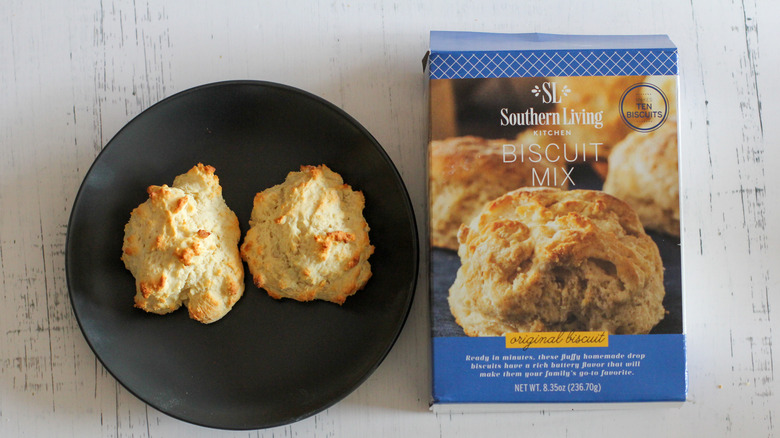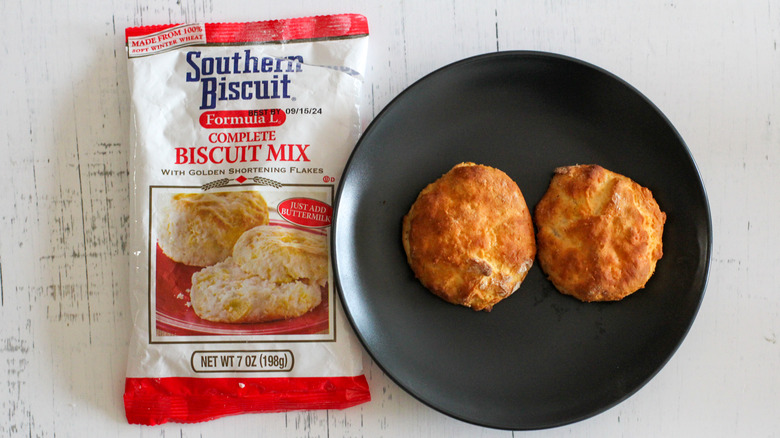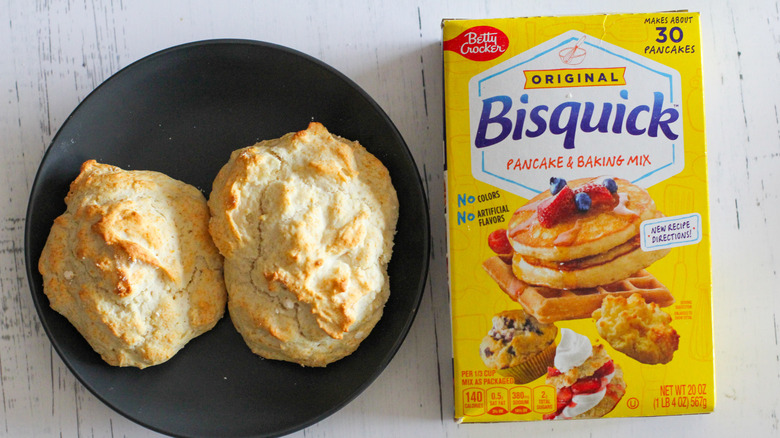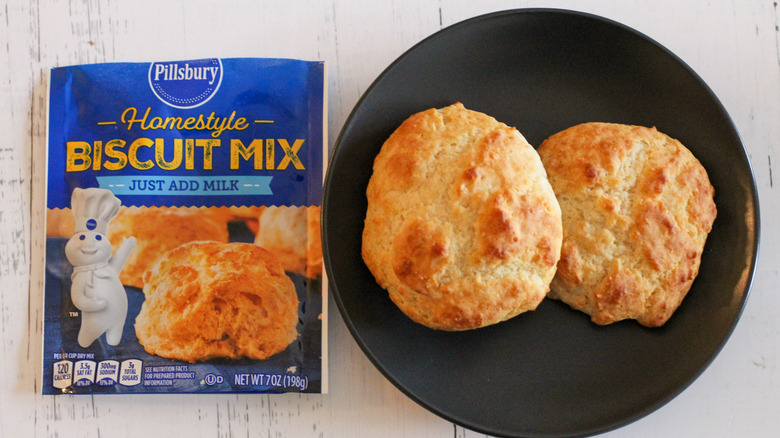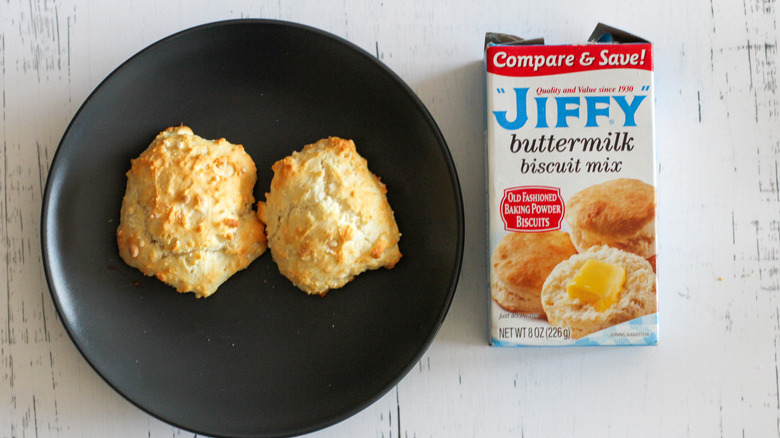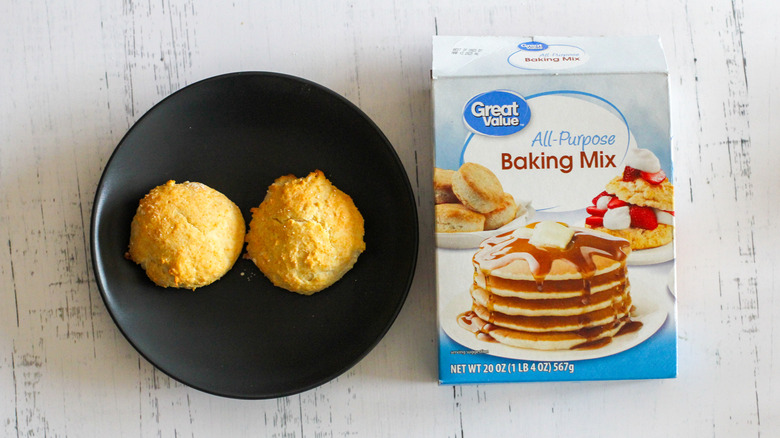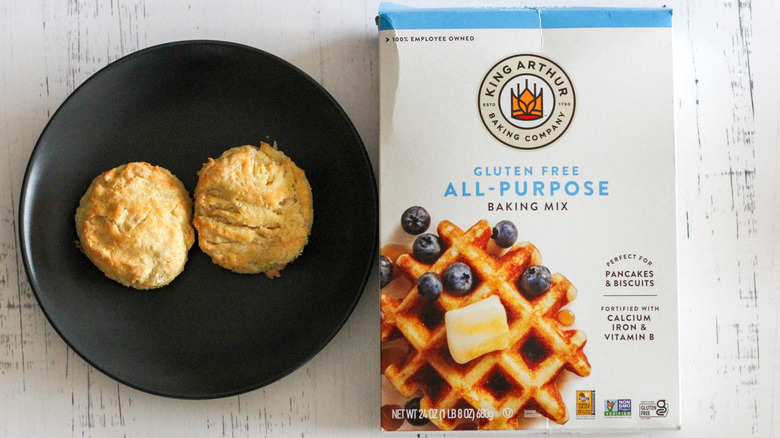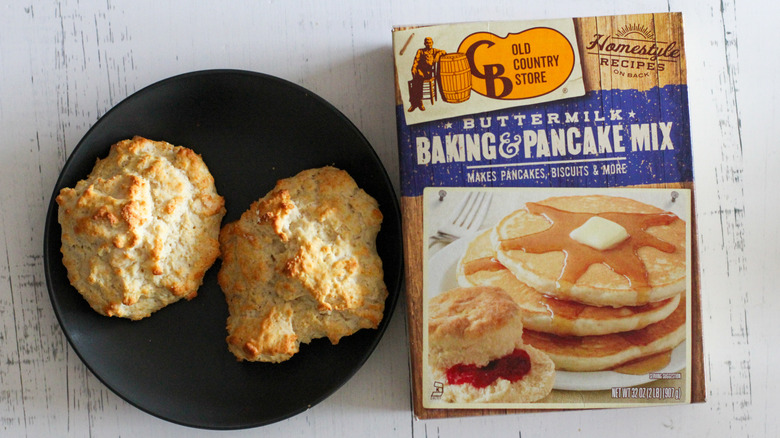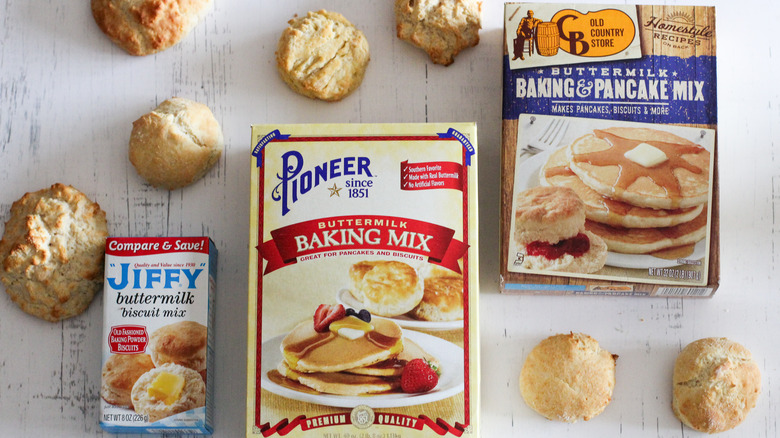12 Store-Bought Biscuit Mixes, Ranked
The baking aisle at the grocery store is a haven for people who like the idea of baking but not the legwork of measuring, mixing, and creating elaborate cakes, cornbread, and other treats from scratch. Rest assured, though, that if you find yourself grabbing a box of pre-made mix from the grocery store, you are no less of a baker than someone who makes everything themselves. If anything, you work smarter — not harder.
Biscuit mixes, like packaged cake mixes, can be great ingredients to keep in your pantry. Generally, these powders are very simple to use; all you have to do is add a liquid ingredient, like milk or water, and you'll have a batter that you can adapt into drop biscuits or cut-out biscuits. Not all biscuit mixes are created equal, though. So, to help you decide which ones to add to your cart, I selected and tested some of the most popular brands. I prepared each according to the recommended recipe and ranked them based on factors like flavor, texture, and ease of use.
12. Duncan Hines Dolly Parton buttermilk biscuit mix
It's probably not a coincidence that my local Walmart was playing "Jolene" when I walked past the baking aisle and saw the Duncan Hines Dolly Parton buttermilk biscuit mix. Dolly herself would have been enamored to see her caricature, complete with blonde flowing locks and a sparkly pink shirt, on the outside of this box. And not to mention, the biscuits on the front look pretty darn good, too.
But I suspect Dolly would have been really disappointed to see how this biscuit mix turned out. It resembled a loaf of bread more than it did a biscuit. The milk didn't absorb into the mix as easily, so there were stodgy bits of dried powder sitting in a milky swamp. The dough mix that was easily incorporated was smooth and elasticky, which made for a biscuit with a breadlike structure and pull. The Duncan Hines mix looked and tasted like a crusty ciabatta, which knocked it down to the bottom of my list. I even made this batch twice (to alleviate any concerns of baker error) and found the same issues.
11. Carbquick Complete pancake and biscuit mix
Carbquick was almost three times as expensive as other products that I sampled for this roundup. It markets itself as a keto-friendly alternative to traditional baking mixes and is made of a proprietary, enzyme-added, wheat-based flour blend. This supposedly mimics the mouthfeel and taste of wheat — just without the extra carbs and calories. In addition to biscuits, the mix can be used for everything from pizza dough to pancakes.
The biscuit recipe was simple; it only called for the powder and water. I immediately noticed very active leavening agents in this mix because they immediately puffed up and started bubbling when I mixed in the water. I could even hear the little air bubbles seizing and popping in the bowl.
The Carbquick biscuits struggled to brown in the oven. The recommended time was 10 to 12 minutes at 350 F, but I had to leave them in the oven for upwards of 15 to even get a little bit of color. The bottoms got golden brown, but the inside stayed moist and soft. It wasn't dry enough to be considered a biscuit, but the crumb inside was still well-structured and tasty. A hotter oven would alleviate some of these issues and bump this biscuit's ranking. But until then, it's at the bottom of the biscuit barrel because of its pale color and high moisture content.
10. Red Lobster honey butter biscuit mix
I'm going to admit it — I've never been to Red Lobster (though there are lots of menu hacks you can try), nor have I ever felt the urge to go. But, if there's one thing I've heard high praise about regarding this chain, it's its cheddar bay biscuits. Although the brand sells a cheddar bay biscuit mix, I wanted to standardize the flavors for this ranking, so I went with a honey butter biscuit mix, instead. I tossed the honey butter packet and just sampled the biscuit mix, which called for water only.
I noticed the raw batter was mealy and almost pebbly in texture. The batter became lumpy when I poured the water in, and the flour didn't evenly disperse throughout. This prevented the smooth consistency that I was looking for. Moreover, the textural issues carried over to when I broke the biscuit into pieces after it was baked. It easily crumbled and shattered all over my hand rather than staying intact. I know biscuits are supposed to be crumbly, but these were far too dry for my liking.
The flavor of these biscuits is more balanced in terms of salt than that of the other brands. However, the lack of that plush, defined pull put them back in the rankings significantly. I hypothesize that swapping the water for milk would have helped hold these biscuits together a little bit more.
9. Southern Living biscuit mix
This biscuit mix from Southern Living showed a lot of promise as a drop biscuit dough. The batter was easy to handle and easily formed a cookie dough-like texture while I was mixing it. I didn't notice the same pebbly issue that I had with Red Lobster or Carbquick, which gave me high hopes for what the dough would look like after a short trip in the oven.
The big downside to this brand was that it was one of the most expensive ones that I sampled and came in a comparatively small package. It wouldn't be the brand I would buy for a large gathering where I was cooking up dozens upon dozens of biscuits, but it would work as a quick side for an intimate family dinner. Plus, the fact that it required melted butter made it a little more laborious than other drop biscuit brands.
The color of these biscuits was sub-optimal, to say the least. The bottoms got perfectly brown, while the tops barely changed color — except in a few spots. The structure of these biscuits was definitely soft and buttery, but it didn't have the dry, slightly crumbly texture that I was looking for. Moreover, I wouldn't have paid the price I did for this biscuit dough, knowing they came out pale and too moist to be considered a classic Southern biscuit. But it still had a better, buttery flavor than the lower-ranked brands.
8. Pioneer buttermilk baking mix
Pioneer's buttermilk baking mix is perfect for biscuits and waffles. Its biscuit recipe differs from some of the others I made because it calls for both melted butter and milk. It's also designed for cut-out biscuits rather than drop ones. So, it was a little more labor-intensive to knead, roll, and shape the biscuit dough. The biggest issue I noticed at the shaping stage was that the dough was very, very sticky. As the recipe noted, I gave it a couple of rounds of light kneading, but it still managed to stick to my hands, the cutter, and the countertop. This consistency also made it difficult to cut through, thus resulting in misshapen biscuits.
The pale color of these biscuits didn't reflect the addition of melted butter, and it was clear that they got a little too poofy in the oven. The uneven rise, as well as a lackluster flavor, gave this mix a spot in the middle of the pack. I also wish that the texture was a bit more crumbly, rather than stodgy and stiff on the inside, and that the bottoms would cook at a similar rate to the top part of the biscuit.
7. Southern Biscuit Formula L mix
I was initially mystified by the small yellow chunks inside of this Southern Biscuit mix. At first, I thought it was cheese, but I looked at the label and quickly realized they were small shortening flakes. This was the only mix I sampled that used these interspersed bits of fat, which I thought could give this biscuit dough a decent rise and flaky layers compared to the other, stodgier biscuits I had sampled.
The Southern Biscuit was easy to roll and shape and wasn't sticky like Pioneer's mix. However, this recipe required buttermilk, which I (as well as many home cooks) do not have on hand at any given time. This can make it a bit tedious to buy a container and then rack your brain about how to use the leftover buttermilk.
I baked these biscuits at the low end of the recommended time. But they came out much more golden brown and borderline burnt compared to the other brands I reviewed. I suspect that bringing the temperature down from the recommended 450 F would have resulted in a biscuit with a lighter color and less of a burnt flavor. As expected, the biscuits had a crunchy shell that distracted from the soft interior. The inside of the biscuit was interspersed with flecks of shortening, but I didn't think it added much buttery flavor. Instead, it just left little yellow dots and a greasy residue on my fingers.
6. Original Bisquick pancake and biscuit mix
Bisquick is easily one of the most well-known breakfast-baking mix brands. Not only does it sell pre-made bottles of shake-and-pour pancake mix, but its bright yellow box makes it one of the most recognizable pancake and biscuit boxed mixes on the shelf. I would have thought that Bisquick would soar to the top based on its reputation alone, but it fell disappointingly short compared to the top brands.
This biscuit mix called for adding vegetable oil to the milk and powder mixture, which wasn't listed in other recipes. Besides this novel addition, I also noticed that these biscuits puffed up significantly when they were in the oven — which was a phenomenon I only noticed with Carbquick. These biscuits were massive and light and airy on the inside, but I think they were too plush. I was waiting for that heaviness to pull me back down to Earth, and I didn't find it in these biscuits. I also didn't think the Bisquick biscuits had any defined taste, and the color was lackluster compared to other brands like Great Value, Pillsbury, and Cracker Barrel.
5. Pillsbury homestyle biscuit mix
Pillsbury was one of the only brands I sampled that made a product specifically for biscuits. Its homestyle biscuit mix came in a small, 7-ounce plastic packet that only required milk. This packet earns high praise for being easy to whip up and toss in the oven.
I made this batch first out of all the brands since it required the lowest oven temperature. The mix came together relatively easily; it retained some small clumps of flour but otherwise mixed together seamlessly. However, despite following the recipe to a T, it went into the oven more wet than I expected. This may have contributed to the massive spread on the baking sheet, which was much more apparent than the other brands.
Overall, this baking mix gets a ton of points for being a breeze to make. But, the bake time took significantly longer than expected, at around 13 minutes. If Pillsbury increased the recommended bake temperature to 400 F, the biscuits may have browned more without spreading. Though, the texture of the biscuit interior was spot-on. It was super soft and fluffy. But, the hard crunch and slight elasticity of the outside of the biscuit was unfortunate because I was looking for a biscuit that had a softer, less bread-like crust.
4. Jiffy buttermilk biscuit mix
I am more familiar with Jiffy's corn muffin and cornbread mix than I am with its buttermilk biscuit mix, but I was excited to try this product. The box itself is quite small and rather inexpensive. Plus, it only requires water to whip up. The entire box only makes about five to six cut-out biscuits (and even more drop biscuits), so it's the perfect size for a side dish.
Working with this dough was nothing short of a nightmare. It had the same crumbly, pebbly texture as the Red Lobster dough, and it didn't develop the elasticity needed to hold together as a cut biscuit. This dough texture would have been perfectly fine as a drop biscuit, but it made for a shaping nightmare. Moreover, these biscuits came out of the oven distorted, which was expected after I saw how wet and troublesome the dough was before it went into the oven. So, they came out more like drop biscuits than rolled and cut ones.
The phrase, "It's what's on the inside that matters," justifies this biscuit's spot in the rankings. Its texture was sublime. The inside was perfectly airy and fluffy, and the crust had the perfect level of crunch. I just wish the dough was easier to work with.
3. Great Value all-purpose baking mix
The Great Value all-purpose baking mix was one of the most inexpensive products I sampled, especially considering the size of the box. This all-purpose baking mix is true to its name; it can be used for waffles, pancakes, or biscuits by tweaking the recipe very slightly. Its back-of-the-box biscuit recipe is only made with milk and the powder mix, which makes it easy to whip up on a busy morning.
The Great Value mix was easier to cut into biscuits than the Pioneer brand but did not slice through quite like the King Arthur Baking Company's product. I think this mix could have easily been made into a drop biscuit without any modification whatsoever — and it would have saved me from getting batter all over my clothes. The color of these biscuits was fantastic, and I would have been proud to serve them at a gathering or event. The inside was soft and crumby, while the outside had a firm coating. However, these biscuits lacked salt and butteriness (especially compared to the King Arthur brand), which prevented them from ranking any higher.
2. King Arthur Baking Company gluten-free baking mix
King Arthur is a well-known brand in the baking world and one that I am very familiar with as a prolific home baker. I have baked with its gluten-free measure-for-measure flour before — for everything from cookies to cinnamon rolls — but I hadn't tried the baking mix before this roundup. This mix can be used for pancakes, waffles, and biscuits (though its website suggests a litany of other uses) and is primarily made of rice flour, starches, and cellulose.
King Arthur's gluten-free biscuit recipe was much more intensive than the other baking mixes in this roundup. Not only did it call for milk, as the other recipes did, but it also called for eggs and unsalted butter. Although it was relatively easy to rub in the pats of cold butter and stir in the other ingredients, it was still more time-consuming than I would have wanted from a "simple" biscuit mix.
The butter quickly leached out of the bottom of these biscuits, as evidenced by the residue on the parchment paper. It also didn't help the biscuits' color, which came out a pale shade of brown. But these were some of the best structured gluten-free biscuits I've ever had. There were defined layers in the dough and a crumbly bite — which made it the only biscuit I came back to for another bite. But, the pale color and tedious ingredient list pushed it out of the top spot.
1. Cracker Barrel buttermilk biscuit & pancake mix
Cracker Barrel was a popular road trip stop when I was a kid. If there was a restaurant in the town my family was visiting, it was on my radar. So, it was exciting to see that the brand sells a buttermilk biscuit and pancake baking mix so that you can bring the euphoric experience of sitting on those old, wooden rocking chairs into your home.
Like other baking mixes on this list, this one can be used for pancakes, waffles, biscuits, and even chicken pot pie. The box mix only calls for milk and shares a solid, step-by-step process for both cut-out and drop biscuits. The mixing was rather straightforward, and the texture of the dough was on par with my other top-performing brands.
Overall, these biscuits were the best in the entire round-up in both color and texture. The light brown hue and firm (yet not bready) exterior were consistent across all the biscuits. When I cracked one open, I immediately noticed that the texture was short and soft with the perfect amount of crumble. Cracker Barrel also beats out the competition in terms of how easy it is to make. No eggs, melted butter, or buttermilk are needed, and the dough is easy to work with. Cracker Barrel is the brand you'll want in your pantry, whether you're serving your biscuits with homemade sausage gravy or butter and jam.
Methodology
I was initially surprised by the sheer number of different biscuit mixes in the store. Each had a slightly different preparation, whether in terms of what ingredients should be added, how long it was baked, or whether it was designed for drop or cut-out biscuits. These factors produced biscuits that had slight variations in flavor and texture, which allowed me to place one above another. I looked for a classic biscuit flavor with buttery notes and a short crumb. Since baking mixes are designed with ease of use in mind, I also prioritized brands that called for a more simplistic ingredient list and were easier to plop on a sheet, shove in the oven, and forget about.
To keep things as standardized as possible, I made plain biscuits rather than ones with chives, cheese, or honey. I also practiced proper baking techniques — including preheating the oven, measuring liquid ingredients as accurately as possible, and using a cool baking sheet for each batch.
